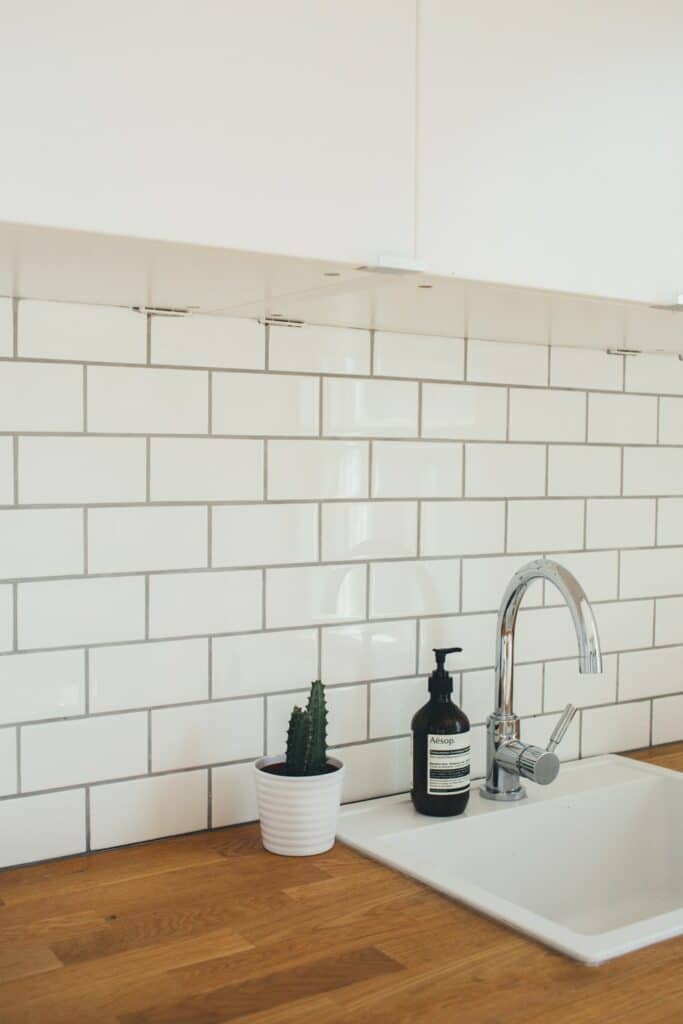Grout Size for Tile Installation, When installing tiles, whether, on the wall or the floor, several rules usually dictate how thick the grout lines have to be.
In most cases, it can be more of a design choice than a requirement. However, there are several important facts and guidelines you should keep in mind when trying to determine how thick your grout lines should be.
The grout line size for tiles is something that comes up with virtually every tile installation. It is a common question and although there are various recommendations for grout size, there’s actually no set width requirement.
In fact, the thickness of the grout joint should be based on several factors including the tile size and amount of variation to your preferred style or aesthetic.
To help make a more informed decision, we’ve developed a list of considerations alongside an overview of options to help you choose the right grout size for your project.
Table of Contents
1/8 Vs 1/16 Grout Size Options

Actual finished grout lines tend to vary from 1/8” to 1/4” where 3/6” spacers are used. If smaller spaces like 1/16” are used it will accentuate the size variation of handmade tile.
Finished grout lines, meanwhile, tend to vary from 1/6” to 3/16”. It’s important to state that using the smallest grout possible will increase the overall installation time.
A 1/8” size is usually used for product/tiles designed with a clean-cut edge. This rectified edge allows for smaller grout lines, especially where tiles have been more precisely cut.
Note that rectified tiles are associated with less irregularity; meaning only less spacing will be needed between each piece. A tight 1/8” grout space may allow the pattern to fit nicely from one tile to the next.
On the other hand, a 1/6” grout size is recommended for tiles with clean edges. Such tiles are often referred to as rectified tiles.
They allow for a tight install. Most brands in this field don’t recommend installing any of their products tighter than 1/16”.
Options like a 3/16” grout size are considered great for ceramic tiles thickness that leaves room for natural variation in size and agreeable imperfect edges of handmade tile.
Grout Size Options
In other words when it comes to size, keep in mind that the tighter the grout joint, the more variation from tile to tile there will be.
This can cause the installation to appear sloppy. In such cases, your tile installer may suggest a larger grout line for a decent, more professional-looking installation.
Although it’s an aesthetic decision whether to go slightly tighter or larger, it’s very trendy to have minimal grout size nowadays.
Nonetheless, that’s not always the best option, especially when dealing with handmade tiles.
Note that grout is meant to serve the purpose of filling in voids, making things straight, and also relieving stress.
Where the grout line is too tight, the tile could chip at stress points after the grout has dried out. Stress from home settling can also be a concern with a little grout space.
This is particularly important for Glass tile installation, given that glass is more sensitive to stress cracking as opposed to ceramic tile.
Small Grout Joints
You’ve probably seen floors or walls where the tiles are installed so close to each other that it almost looks like there is no grout at all.
Rectified tiles are often considered the only way to achieve this look. Average tiles are basically natural products that are rarely exactly the same size and shape, thus the need for a grout line.
Rectified tiles feature clean, cut edges and are uniform on all sides.
Little grout line width (like the 1/6 inch discussed above) can be achieved with rectified tiles.
One impressive thing about installing rectified tile flooring with small grout lines is that it decreases maintenance requirements and looks great.
On the flip side, it may be more time-consuming and hard to achieve considering that there’s little wiggle room during installation. Grout that’s not sanded is recommended for small joints up to 1/8”.
Medium Grout Joints
Medium grout joints are 1/8″–1/4″. These require sanded grout and are used when tiles vary in size or are lugged.
Since medium size grout line is easier to work with, it is usually easy to hide imperfections. Perhaps that’s why they’re the choice of both experts and average DIY homeowners.
Large Grout Joints
Tiles that vary in shape and size require large grout joint widths- from 3/8” to 1/2″. Large grout lines will require the use of sanded grout.
For instance, marble flooring installed in different-sized, repeating patterns, such as the Versailles pattern necessitates large grout line widths. Overall, provided you follow the manufacturer’s recommendations, your grout line can be both functional and a statement of style.
What to Consider When Choosing Grout Size
Variation in size from tile to tile
When doing the installation, there can be a significant amount of variation in size and thickness from tile to tile.
With handmade tiles, Grout Size for Tile Installation recommended that you use larger grout joints to accommodate these irregularities. Tiles may fluctuate by minus 1/8” in size and thickness and in any direction. Thus, the amount of variation in size from tile to tile is a factor to consider.
Size of the Tile
The size of your tile is another factor to consider when deciding on a grout size. In most cases, there’s more size variation in larger-sized handmade tiles so they require a bigger grout joint to make them less noticeable and achieve a more even installation.
The place where you’re doing the installation should also be considered when choosing your grout size. For instance, floor installations should involve using greater grout lines for more traction.
The grout size should also be considered when there’s a variation in the angle of a surface. If the floor isn’t level, the grout will slope from one tile to another. Keep in mind that when tiling over a corner, the grout joint will open up and narrow in when tiling into a recess.
Different Grout Sizes
Actual finished grout lines will vary from 1/8″ to ¼” where 3/6″ spacers are used. Use of a smaller space like 1/16″ will accentuate the size variation of handmade tile. The finished grout line tends to vary from 1/6″ to 3/16″. Knowing that using minor grout possibly increases the available installation time is paramount.
For tiles or products with a clean-cut edge, a 1/8″ is ideal as the rectified edge allows for smaller grout lines. For records, the rectified tiles link to minimal irregularity; they require less space between each piece, and a 1/8″ grout space may give a perfect pattern from one tile to the next.
Alternatively, for tiles with clean edges like rectified tiles, it is recommendable to use 1/16″ grout size tiles allowing for a tight install. However, most brands discourage the installation of their product closer than 1/16″
Ceramic tiles’ thickness leaves room for natural variation in size and agreeable imperfect handmade tiles, making a 3/16″ grout size a great option. Conclusively, when it comes to grout sizes, it is essential to note that the tighter the grout joint, the more the variation from tile to tile, causing the whole installation to look sloppy.
Let your tile expert advise you on a larger grout for a modern, professional-looking installation in such a scenario. Even though going tighter or more significant is a personal aesthetic choice, minimal grout size is trendy.
However, it may not be the perfect option for handmade tiles. The bottom line is that grout intends to fill in voids, relieve stress, and make things even.
Grout Size Recommendations
For every tile installation, the grout line size is a common concern and a question that rises almost daily. While there are recommendations for grout size for each tile product line, there is no set width standard.
However, the thickness of the grout joint depends on several factors like tile size and the variation amount to your aesthetic. Therefore, knowing what to consider during your grout size selection is good.
Size Variation
There is considerable variation in size and thickness from one tile.
Therefore, larger grout joints are recommended for handmade tiles to cover any irregularities like tiles can fluctuate by1/8″ in size and thickness.
Tile Size
When selecting a grout size, another factor to look at is your tile size. The more size variation in larger-sized tiles, the bigger the grout joint for that to become invisible and for a more even installation
Where to Install the Tiles
The tile’s placement also plays a part when choosing your grout size. For instance, floor installation should consider more prominent grout lines for more traction.
Grout Size for Tile Installation should consider a grout size when there is a difference in the surface angle. For unlevel surfaces, the grout will slope from tile to tile. When tiling a corner, your grout joint will open up, and when tiling into a recess, the grout joint top narrows in.
3/16 Grout Line vs. 1/8
The two grout lines have a number difference that makes them unique, which determines how you can install them, the tiles you can use alongside them, etc.
The main difference is that a 1/8” grout line is ideal for small tiles and offers clean edges to your tile job. On the other hand, 3/16” is perfect for larger tiles, and if they are not the rectifying type
1/16 vs. 1/8 Grout Lines for 3X6 Subway Tile

Subway tiles are rectangular, usually 3×6 inches, and made of ceramic tiles. It is viral for both its durability and ageless style. How big should its grout lines be? Since it is a 3x 6-inch subway tile, it has a grout joint of 1/16 inch. However, 1/8 inch grout joint is also typical.
Because 3×6 inch subway tiles are small, it would be better to use smaller spacers like 1/16 inch or 1/8 inch. However, a 1/8 inch size spacer will create a thinner grout line giving a seamless look to your project.
Floor Tile Grout Spacing
A rule of the thumb is that floor tiles should have grout lines of 1/8” or larger based on the floor type and the tile size.
Particular types like slate or quarry tiles don’t even have edges to work with tight spacing. As a result, they use spacers with grout lines 3/16″ or wider.
Plastic spacers are used at the tile corners to create uniform grout spaces.
Large-format tiles- 18 by 18 inches square or more significant- look impressive with very narrow grout lines filled with a grout color that blends the tile resulting in a single slab kinder floor.
¼ Inch Grout Lines
It is a medium-size grout line that needs the Use of sanded grout and features when there is moderate variation in tiles or tiles with lugs. It is easier to work with and covers slight imperfections making it a favorite by professionals and DIY homeowners.


